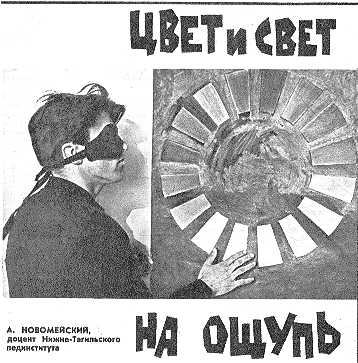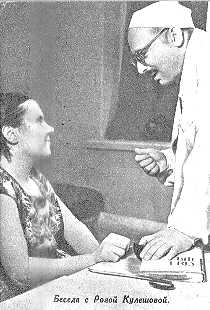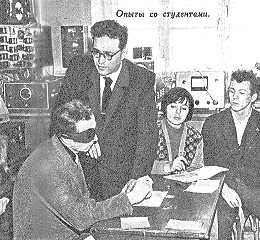 In pre-revolutionary
scientific literature there was a women described, who was able,
with her eyes covered with a bandage, identify colours and read
through sealed envelopes touching them with the tips of her
fingers. But still, you can not help being greatly impressed when
you meet Rosa Kuleshova. How can we explain her amazing ability
to determine inscriptions, made in different types, drawings on
post cards, colour of paper, fabrics, threads Just touching them?
The experiments, made by senior lecturers S.Dobronravov and Y.
Fishelev (Sverdlovsk-city) and further research, made in the
laboratory of Psychology of the Nizhny Tagil Teachers' Training
Institute by Dr. I.Goldberg, senior lecturer M.Kojevnikov and the
auther of this article, made it possible to conclude that Rosa
has the type of sensitivity that can be called dermo-optical
perception.
In pre-revolutionary
scientific literature there was a women described, who was able,
with her eyes covered with a bandage, identify colours and read
through sealed envelopes touching them with the tips of her
fingers. But still, you can not help being greatly impressed when
you meet Rosa Kuleshova. How can we explain her amazing ability
to determine inscriptions, made in different types, drawings on
post cards, colour of paper, fabrics, threads Just touching them?
The experiments, made by senior lecturers S.Dobronravov and Y.
Fishelev (Sverdlovsk-city) and further research, made in the
laboratory of Psychology of the Nizhny Tagil Teachers' Training
Institute by Dr. I.Goldberg, senior lecturer M.Kojevnikov and the
auther of this article, made it possible to conclude that Rosa
has the type of sensitivity that can be called dermo-optical
perception.
Back
FINGER PERCEIVES THE
LIGHT
Rosa feels the colour of the light, penetrating through light
filters and falling onto her fingers. Rosa says: " This ray
is red, that ray is green; that one is orange, and the other one
is blue". Moreover, she is able to identify not only a
bright ray of light, but a weak one as well. She can even better
identify coloured rays, let through the lens filled with water
and then reflected on her hand with a mirror.
It was noticed, that sometimes while reading, her fingers are
below the line, but Rosa is still able to read what is written
there. To understand this phenomenon, an experiment was set up.
Grey-colored triangles, placed against a bright-colored
background: first red, then green, and then the yellow one were
shown to Rosa. Those grey triangles, due to the contrast effect,
visually acquire, especially on the edges, the shade
complementary to the color of the background - against the red
background gray triangles turn green, against the green
background they seem pinkish, on the yellow - blue. Rosa's finger
was put in the middle of the grey triangle so that it would not
touch the surrounding coloured background. Every time she
identified the surface not as grey but as a coloured one, the
color being complementary to the background: green, pink, blue.
It means that her fingers perceived the light, reflected from the
neighbouring coloured parts. The ability of sensing colour
differences allowed Rosa to read with her hand texts and numbers
through glass and cellophane, define shape and colour of the
curve on the oscillograph screen, and level, and sometimes even
colour of liquids in a test-tube.
SIMILARITY OF USUAL AND
UNUSUAL VISUAL PERCEPTION
Rosa's dermo-optical perception is subject to the same laws of
colour merging as our visual perception. When Rosa touched a blue
square placed into red light, she saw it as violet, as did the
experimenter who was watching it at the same time. When instead
of red light it was illuminated with white, then both Rosa with
her fingers and the experimenter with his eyes identified the
square as blue.
Paper, for example, is perceived by us as white no matter if
it is in bright sunlight, twilight or electric light. If the same
paper in placed into bright coloured light, for example, red, it
takes he color of the light and looks red. Strange as it may
seem, but Rosa Kuleshova, with her ability for skin-optical
perception, perceives the paper as white, even if it is placed
into the direct rays of red.
Rosa Kuleshova is also experiencing more vivid optical
illusions than all of us, who do not possess the ability for
cutaneous-optical perception.
WHAT ARE THE DIFFERENCES
?
 Dermo-optical
perception has some piculiarities which can not be seen by human
eye. Rosa learned to identify by touch colour shades, letters and
numbers through a sheet of white paper.
Dermo-optical
perception has some piculiarities which can not be seen by human
eye. Rosa learned to identify by touch colour shades, letters and
numbers through a sheet of white paper.
While using fingers, perception of electromagnetic vibration
with the help of cutaneos analysis leads to appearing in human
mind of not visual but special optical forms of skin sensitivity.
Rosa can not always describe them, but she says that she senses
every colour in a special way - like "crosses", "dots",
"curves", "lines" etc. These cutaneous-optical
feelings are the signals for her to identify certain colours and
change in illumination of the objects, the same as visual forms
are signals for us. During the experiments it was noticed that
Rosa's cutaneous-optical sensitivity is often associated with
certain verbal symbols, not based on the visual perception and
imagination. She, for example, can easily memorize a new,
unfamiliar colour, only touching it with her fingers and learning
its name.
Afterwards, skin feelings of this colour gets closely
connected with the name of the colour so she easily recognizes it
when touching it again.While reading and touching the pictures
view sight disturbs her, and that is why Kuleshova tries to tie
the bandage as tight as possible, so that no light could
penetrate into her eyes. It is important to mention that Rosa
Kuleshova is not just a person being tested but she is also a
well trained, inventive experimenter. Sometimes during the
experiment she finds a new solution or offers an original way or
method.
WHAT ARE THE
PERSPECTIVES?
 Rosa Kuleshova's case
is very interesting, but still it is a single one. Can the
cutaneous- optical sense be developed in other people? For that
reason the Pedagogics and Psychology Department of Nimy Tagil
Teachers' Training Institute set up an experiment among the
students of Art and Graphics Faculty. 50 art students were
selected to participate. They started intensive training in
determining colors with tips of their fingers. During the
training period their eyes were tied with black wadding bandage.
View sight was not involved at all. From 50 students 10 showed
good ability of cutaneous-optical perception. They learned to
identify two and then three and more colours. All the
regularities of colour sense, that were revealed during the
experiment with Rosa Kuleshova, were observed among the students.
This information makes it possible to find new methods of
treating people with eye problems.
Rosa Kuleshova's case
is very interesting, but still it is a single one. Can the
cutaneous- optical sense be developed in other people? For that
reason the Pedagogics and Psychology Department of Nimy Tagil
Teachers' Training Institute set up an experiment among the
students of Art and Graphics Faculty. 50 art students were
selected to participate. They started intensive training in
determining colors with tips of their fingers. During the
training period their eyes were tied with black wadding bandage.
View sight was not involved at all. From 50 students 10 showed
good ability of cutaneous-optical perception. They learned to
identify two and then three and more colours. All the
regularities of colour sense, that were revealed during the
experiment with Rosa Kuleshova, were observed among the students.
This information makes it possible to find new methods of
treating people with eye problems.
"Engineering
- youth" 4/1963.
Back
 In pre-revolutionary
scientific literature there was a women described, who was able,
with her eyes covered with a bandage, identify colours and read
through sealed envelopes touching them with the tips of her
fingers. But still, you can not help being greatly impressed when
you meet Rosa Kuleshova. How can we explain her amazing ability
to determine inscriptions, made in different types, drawings on
post cards, colour of paper, fabrics, threads Just touching them?
The experiments, made by senior lecturers S.Dobronravov and Y.
Fishelev (Sverdlovsk-city) and further research, made in the
laboratory of Psychology of the Nizhny Tagil Teachers' Training
Institute by Dr. I.Goldberg, senior lecturer M.Kojevnikov and the
auther of this article, made it possible to conclude that Rosa
has the type of sensitivity that can be called dermo-optical
perception.
In pre-revolutionary
scientific literature there was a women described, who was able,
with her eyes covered with a bandage, identify colours and read
through sealed envelopes touching them with the tips of her
fingers. But still, you can not help being greatly impressed when
you meet Rosa Kuleshova. How can we explain her amazing ability
to determine inscriptions, made in different types, drawings on
post cards, colour of paper, fabrics, threads Just touching them?
The experiments, made by senior lecturers S.Dobronravov and Y.
Fishelev (Sverdlovsk-city) and further research, made in the
laboratory of Psychology of the Nizhny Tagil Teachers' Training
Institute by Dr. I.Goldberg, senior lecturer M.Kojevnikov and the
auther of this article, made it possible to conclude that Rosa
has the type of sensitivity that can be called dermo-optical
perception. Dermo-optical
perception has some piculiarities which can not be seen by human
eye. Rosa learned to identify by touch colour shades, letters and
numbers through a sheet of white paper.
Dermo-optical
perception has some piculiarities which can not be seen by human
eye. Rosa learned to identify by touch colour shades, letters and
numbers through a sheet of white paper.  Rosa Kuleshova's case
is very interesting, but still it is a single one. Can the
cutaneous- optical sense be developed in other people? For that
reason the Pedagogics and Psychology Department of Nimy Tagil
Teachers' Training Institute set up an experiment among the
students of Art and Graphics Faculty. 50 art students were
selected to participate. They started intensive training in
determining colors with tips of their fingers. During the
training period their eyes were tied with black wadding bandage.
View sight was not involved at all. From 50 students 10 showed
good ability of cutaneous-optical perception. They learned to
identify two and then three and more colours. All the
regularities of colour sense, that were revealed during the
experiment with Rosa Kuleshova, were observed among the students.
This information makes it possible to find new methods of
treating people with eye problems.
Rosa Kuleshova's case
is very interesting, but still it is a single one. Can the
cutaneous- optical sense be developed in other people? For that
reason the Pedagogics and Psychology Department of Nimy Tagil
Teachers' Training Institute set up an experiment among the
students of Art and Graphics Faculty. 50 art students were
selected to participate. They started intensive training in
determining colors with tips of their fingers. During the
training period their eyes were tied with black wadding bandage.
View sight was not involved at all. From 50 students 10 showed
good ability of cutaneous-optical perception. They learned to
identify two and then three and more colours. All the
regularities of colour sense, that were revealed during the
experiment with Rosa Kuleshova, were observed among the students.
This information makes it possible to find new methods of
treating people with eye problems.